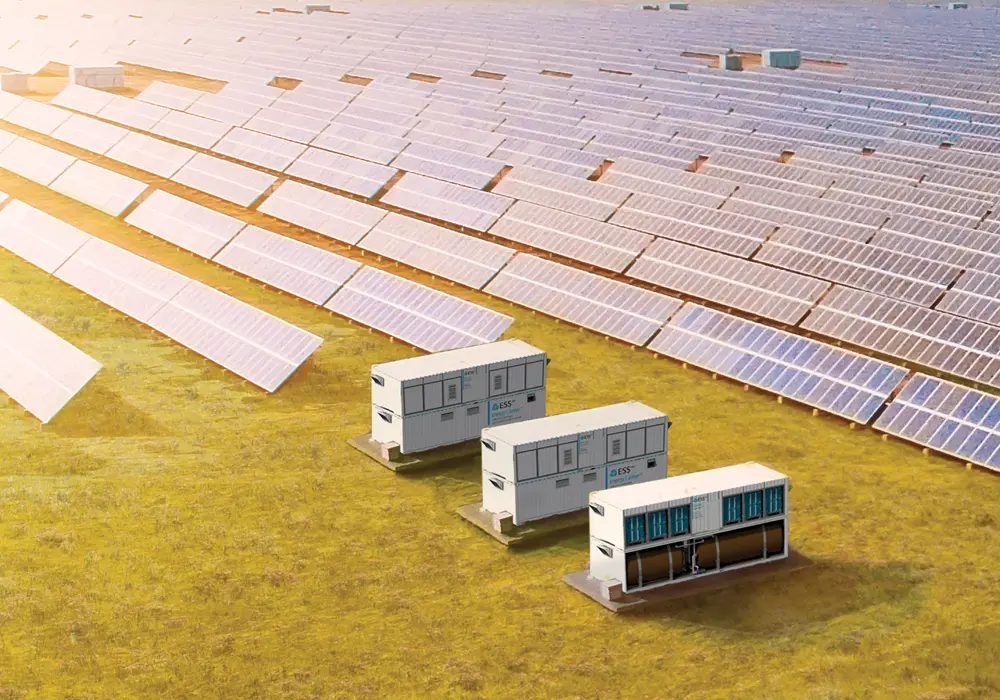Green Baseload Energy
Delivering clean, resilient baseload energy.

Intermittent renewable resources are among the lowest cost generation resources, and the primary source of new generation capacity. Integrating increasing amounts of wind and solar energy will require grid-scale long-duration energy storage to maintain grid stability and deliver reliable, clean energy.
With long-duration energy storage, it’s possible to meet the growing demands of AI data centers and an increasingly electrified society while ensuring grid reliability and optimizing generation and transmission resources.




Energy Storage
Use Cases
Renewable optimization
Peaker plant replacement
Ancillary services
Capacity reserve
Grid resiliency
PV and wind shifting
Downloads
Use case
LEAG
ESS Tech, Inc. (ESS) and LEAG are engaged in preliminary engineering planning for the first phase of a 50 MW / 500 MWh iron flow system. The storage project is expected to be sited at the Boxberg Power Station, a coal-fired generator in Eastern Germany.
This 50 MW / 500 MWh project will support LEAG’s broader ambition to develop the largest clean energy hub in Europe, including up to 14 GW of wind and solar, 2-3 GWh of long-duration energy storage and some hydrogen, providing a blueprint for the transition from a coal-based utility to a fully renewable and decarbonized generator.
This project demonstrates green baseload generation without natural gas at gigawatt scale. As a compelling case study in the replacement of fossil fuels for baseload energy with renewables and storage and long-term economic growth in fossil-dependent regions, there is strong interest in the project from a number of public and private stakeholders.

Use case
Queensland, Australia
In August 2023, the government of Queensland, Australia announced two initial utility projects incorporating ESS systems, manufactured by ESS in the United States and supplied by ESI. These projects, the Stanwell Clean Energy Hub and an Energy Queensland network battery project, are the first of their kind in Australia and will demonstrate the key role of long-duration energy storage in the transition of large, baseload coal generation and legacy distribution networks to clean energy.
Demand for LDES in the region is strong and expected to grow. McKinsey & Co. and the LDES Council predict that Australia will need up to 40 GW of storage capacity by 2040 to support decarbonization and increased renewables on the grid.
The first fully assembled ESS system was delivered to Australia in October 2022 and is in operation at the Queensland University of Technology. ESS and ESI will work cooperatively to deliver the best solutions and value to our customers. In 2025, ESI is expected to begin assembly of Energy Warehouse systems in Australia, including sourcing balance-of-plant and other components locally. However, ESS will continue to supply core technology (including power modules, proton pumps, software, etc.) from the United States. While ESI’s manufacturing facility is under construction, ESS will continue to deliver fully assembled Energy Warehouse systems to ESI to meet immediate demand for LDES.
Recently, multiple Australian state governments have announced targets for LDES integration:
For example, the government of New South Wales announced the procurement of 2 GW of LDES by 2030 as part of the Electricity Infrastructure Roadmap. This new LDES capacity will enable the replacement of the state’s five coal-fired generating stations with clean, renewable energy.
Victoria has announced an even more aggressive target: 2.6 GW of storage by 2030, increasing to 6.3 GW by 2035.


